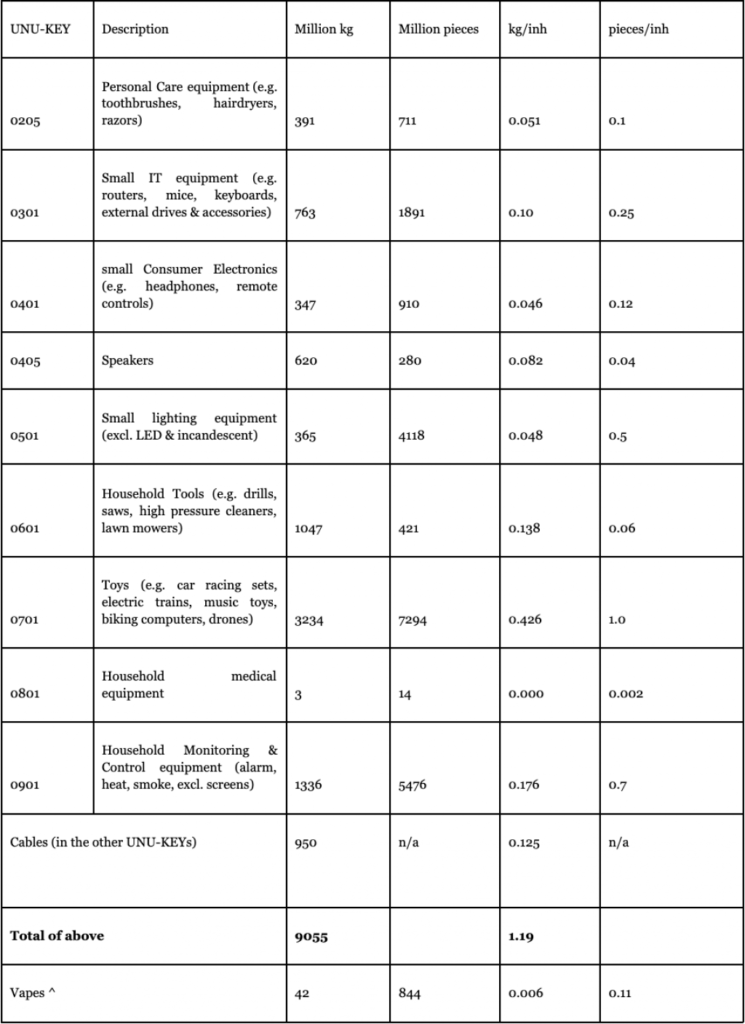Why is E-waste in discussion?
Recently, on the occasion of International E-Waste Day (14 October), the Brussels-based Waste Electrical and Electronic Equipment (WEEE) Forum partnered with the United Nations Institute for Training and Research (UNITAR) to calculate the annual volume of invisible E-waste items. Appointed.
Table of Contents
- Invisible e-waste refers to electronic waste that often goes unnoticed due to its nature or appearance, causing consumers to overlook its recyclable potential.
- Invisible E-waste refers to electronic waste that goes unnoticed, with consumers ignoring its recyclable potential.
- There are many electronic items falling under this category, such as cables, e-toys, e-cigarettes, e-bikes, electrical appliances, smoke detectors, USB sticks, wearable health devices smart home gadgets, etc.
Invisible e-waste generated

WEEE Forum:
- It is the world’s largest multinational competence center on operational information related to the management of ‘Waste Electrical and Electronic Equipment‘ (or ‘WEEE’ for short).
- It is a non-profit association of 46 WEEE producer responsibility organizations from around the world and was founded in April 2002.
- The WEEE Forum gives its members the opportunity to improve their operations and position themselves as promoters of the circular economy through the exchange of best practices and access to its prestigious knowledge base toolkit.
Key facts of the study:
Amount of invisible e-waste:
- Consumers do not identify approximately one-sixth of the annual global total of approximately 9 billion kilograms of electronic waste. About 35% of invisible e-waste (about 3.2 billion kilograms) comes from the e-toy category, which includes race car sets, electric trains, drones, and biking computers.
- An estimated 844 million vaping devices are discarded annually, contributing significantly to the growth of invisible e-waste.
Value of Invisible E-Waste:
- The physical value of invisible e-waste is approximately US$9.5 billion each year, reflecting its economic importance mainly due to components such as iron, copper, and gold.
Global E-Waste Management and Recycling Challenges:
- Only a small portion of e-waste is properly collected, treated, and recycled globally.55 percent of e-waste generated in Europe is now officially collected and reported. Yet the average collection rate reported in other parts of the world is slightly higher, at 17 percent. Most waste is dumped into landfills, burned, illegally traded, treated improperly, or stored in homes.
- Lack of public awareness hinders efforts to develop a circular economy for electronic devices in different parts of the world, necessitating a global approach to e-waste management.
Environmental concerns:
- Improper disposal of invisible e-waste poses a major environmental risk, as these items contain hazardous compounds, such as lead, mercury, and cadmium, which can contaminate soil and water if not properly managed.
Recommendations:
- Invisible e-waste represents an untapped resource, hence there is an urgent need to raise awareness about the economic recovery potential and recycling of these valuable resources. The value of raw materials in global e-waste generated was estimated at US$57 billion in 2019. One-sixth of the total value of US$9.5 billion worth of material annually comes in the category of invisible e-waste.
- It is necessary to increase recycling capacity and awareness to meet the growing demand for materials in various strategic sectors such as renewable energy, electric mobility, industry, communications, aerospace, and defense.
Provisions regarding e-waste in India:
- The E-Waste (Management) Rules, 2016 were enacted in the year 2017, which included more than 21 products (Schedule-I) under the ambit of the rule. This included compact fluorescent lamps (CFL) and other mercury-containing lamps, as well as other such devices.
- In the year 2011, an important notice was issued regarding the E-Waste (Management and Handling) Regulations of 2010 governed by the Environment (Protection) Act, of 1986.
- Extended Producer’s Responsibility (EPR) was its main feature.
Extended Producer’s Responsibility (EPR) was its main feature
- The Government of India notified the E-Waste (Management) Rules, 2022 with the key objective of digitalizing the e-waste management process and increasing visibility. It also prohibits the use of hazardous substances (such as lead, mercury, and cadmium) in the manufacturing of electrical and electronic equipment, which have adverse effects on human health and the environment.
- The government has introduced a deposit Refund Scheme as an additional economic instrument in which the producers take an additional amount as a deposit at the time of sale of electrical and electronic components and return it to the consumer with interest as per market norms. When power and electronic equipment are finally returned.
Conclusion:
- It is imperative to address the issue of “invisible e-waste” to achieve sustainable waste management and environmental protection.
- About the recyclability of these often-overlooked electronic items.
- Read more latest news








[…] 9 billion kg e-waste goes unrecognized every year globally: A Global Threat […]
[…] 9 billion kg e-waste goes unrecognized every year globally: A Global Threat […]